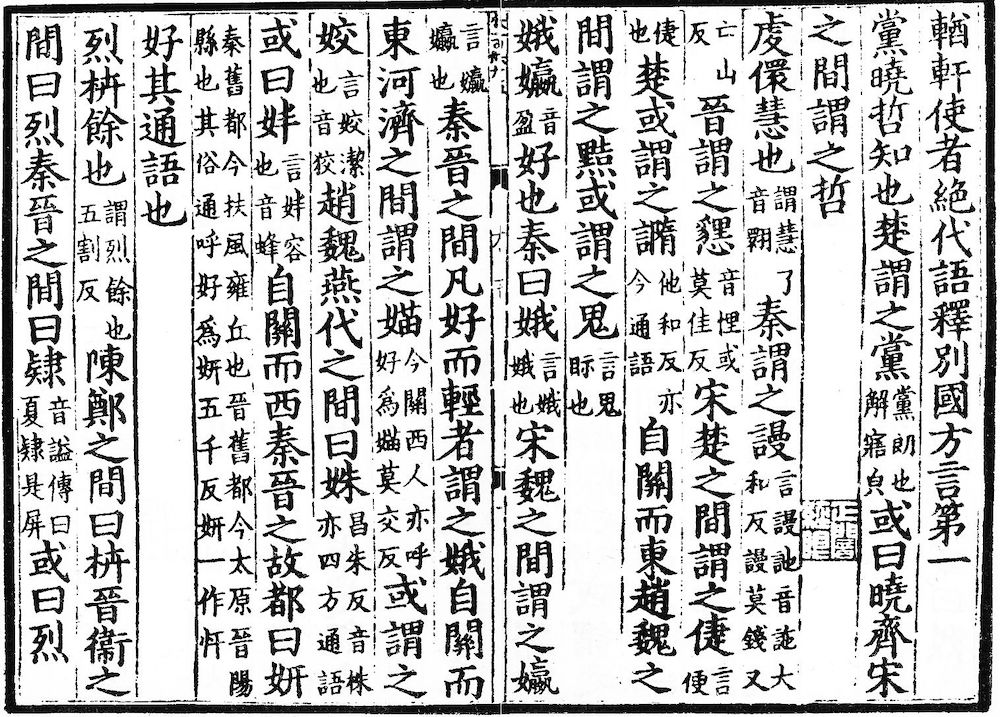Fangyan 方言 is a topolect dictionary of the regional tongues of Han period 漢 (206 BCE-220 CE) China. It was written by the late Former Han period 前漢 (206 BCE-8 CE) scholar Yang Xiong 揚雄 (53 BCE-18 CE). Its full title is Youxuan da shizhe juedai yushi bieguo fangyan 輶軒大使者絕代語釋別國方言 "The Grand Carriage-Equipped Commissioner's book on topolects, covering all times and explaining the tongues of various regions". From this title it becomes evident that it was written as a manual for representatives of the imperial court to the various regions of the empire to have an easier access to the local languages. It book 13-juan long.
 |
Beginning of the Fangyan, Sibu congkan 四部叢刊 edition, reproducing a Song period print from the collection of the family Fu 傅氏 from Jiang'an 江安, Sichuan (Shuangjian Studio 雙鑑樓). Click to enlarge. |
The catalogue of the imperial library and Yang Xiong's biography, both included in the official dynastic history Hanshu 漢書 (see Yiwen zhi 藝文志), do not mention the Fangyan. Traditional scholars therefore saw the Fangyan as a forgery of later date. It is at least known that there were similar collections on local languages (topolects) during the Qin 秦 (221-206 BCE) and Han periods, a base upon which Yang Xiong could have compiled his dictionary.
The Fangyan contains information about the topolects of China's regions (or provinces), which are called with the traditional names like Qin 秦 (Shaanxi), Jin 晉 (Shanxi), Qi 齊 (Shandong), Song 宋 (Henan), Yan 燕 (Hebei), Chu 楚 (Hebei, Henan) and so on, but also of the Non-Chinese population in the south.
The lexemes of the Fangyan are arranged in glossary groups. For each entry it is explained if a word is commonly used throughout the empire (tongyu 通語) or only in certain regions. A special group of words are characterised as "transmitted words" (zhuanyu 轉語) if the original pronunciation of the character has changed by its transmission through time or from one region to the other. The author of the Fangyan does not mention his sources nor is he concerned about the characters by which the word he quotes are written down. The Fangyan is a momentaneous picture of the linguistic situation of China during the mid-Han period.
During the Eastern Jin 東晉 (317-420) period Guo Pu 郭璞 (276-324) wrote a commentary, the Fangyan zhu 方言注. It is included in the reprint series Sibu congkan 四部叢刊. It is very interesting for scholars of ancient Chinese phonology to see how the sound had changed from the 1st cent. BCE to the 4th century, an observation which already Guo Pu experienced in his study of the Fangyan. Guo Pu renders information if a certain topolect word still existed in his times or had only appeared in earlier times.
All recent versions of the Fangyan are based on Guo Pu's copy which probably differed from Yang Xiong's original (Guo Pu speaks of 15 juan, and his version contains almost 2,000 characters more than the Han period original).
During the Qing period 清 (1644-1911) the scholar Dai Zhen 戴震 (1723-1777) wrote the commentary Fangyan shuzheng 方言疏證. It is included in the reprint series Siku quanshu 四庫全書. Dai Zhen revised the errors that had crept into the various Fangyan manuscripts. He made use of the Ming period 明 (1368-1644) print version included in the encyclopaedia Yongle dadian 永樂大典 and looked for quotations from the Fangyan and Guo Pu's Fangyan zhu in other sources.
Wang Niansun 王念孫 (1744-1832) later added and revised some points Dai Zhen had overlooked and published his commentary Fangyan shuzheng bu 方言疏證補. Qian Yi 錢繹 (early 19th cent.) wrote the commentary Fangyan jianshu 方言箋疏. This commentary is a philologically very rich book which quotes a vast amount of contemporary literature. Yet it neglects the fact that the Fangyan is a momentary record of Han period language and not a grammar of ancient Chinese.
The first print of the
Hang Shijun 杭世駿 (1696-1773) wrote a continuation called Xu fangyan 續方言, with a length of 2 juan. It is included in the series Yihai zuchen 藝海珠塵. Dai Zhen's somewhat longer Xu fangyan is found in the series Anhui congshu 安徽叢書.
| 黨、曉、哲,知也。楚謂之黨,〈黨,朗也,解寤㒵。〉或曰曉,齊宋之間謂之哲。 | Clear, bright, wise, means "to know". In Chu (Hubei), the word 黨 "clear" is used ([Guo Pu's commentary:] 黨 means "clear", "to become aware"); some say 曉 "bright", and in the region of Qi and Song (Shandong), the word 哲 "wise" is used. |
| 虔、儇,慧也〈謂慧了。〉。秦謂之謾〈言謾訑。〉,晉謂之㦟,宋楚之間謂之倢〈言便倢也。〉,楚或謂之䜏〈亦今通語。〉。自關而東趙魏之間謂之黠,或謂之鬼。〈言鬼眎也。〉 | Reverent, clever, means "intelligent" (means, "to understand"). In Qin (Shaanxi), people say 謾 "deceitful" (means, "to feint"), in Jin (Shanxi) 㦟 "astute", in the regions between Song and Chu (i.e. northern Anhui), people say 倢 "handsome" (means, "favourite"), and in Chu (Hubei) 䜏 "quick-witted" (still used today); from the Pass (around today's Xi'an, Shaanxi) eastwards, in Zhao and Wei (Henan, southern Shanxi), people say 黠 "cunning" or 鬼 "spirited" (means, "spiritful obervation"). |
| 庸謂之倯,轉語也。〈倯猶保倯也。今隴右人名孏為倯。〉 | Uneven is called "stupid"; this is a word which has transformed. ("Stupid" means "to remain idle". Today, the people in the region of Longyou - western Shaanxi, Gansu - say "stupid" if they mean 孏 "dumb".) |
| 雞,陳楚宋魏之間謂之鸊鴟,桂林之中謂之割雞,或曰声。北燕朝鮮洌水之間謂伏雞曰抱〈江東呼蓲。〉。爵子及雞雛皆謂之鷇。其卵伏而未孚始化謂之涅。 | Chicken (雞 ji) are called pichi 鸊鴟 in the region of Chen, Chu, Song and Wei (Hubei, Anhui, Henan), in Guilin they are called geji 割雞 or cong 𩀨. in the northeast, a breeding hen is called bao 抱 (in eastern Jiangsu and Zhejiang known as qiu 蓲); fledglings are called gu 鷇; if the eggs are just laid and not yet bred, and just begin to transform, they are called nie 涅. |